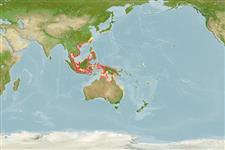Actinopterygii (ray-finned fishes) >
Scorpaeniformes (Scorpionfishes and flatheads) >
Platycephalidae (Flatheads)
Etymology: Grammoplites: Greek, gramma, atos = signal, mark + Greek, hoplon = shield (Ref. 45335).
Environment / Climate / Range
Ecology
Marine; demersal; non-migratory; depth range ? - 32 m (Ref. 9790). Tropical, preferred ?
Western Pacific: Hainan Island, China, the South China Sea, the Gulf of Thailand and Johore shoals of Malaysia.
Size / Weight / Age
Maturity: Lm ? range ? - ? cm
Max length : 30.0 cm TL male/unsexed; (Ref. 9790); common length : 25.0 cm tl male/unsexed; (Ref. 9790)
Short description
Morphology | Morphometrics
Dorsal
spines
(total): 9;
Dorsal
soft rays
(total): 12;
Anal
spines: 0;
Anal
soft rays: 12. Lateral line scales frequently 53, each scale with a backward directed spine that does not extend beyond rear margin of scale. Interorbital width less than 9% of head length. Caudal fin frequently with 2 dark bands posteriorly. Dorsal fin rays IX, I,VIII, or I,VII,I, usually I,VIII.
Life cycle and mating behavior
Maturity | Reproduction | Spawning | Eggs | Fecundity | Larvae
Knapp, L.W., 1999. Platycephalidae. Flatheads. p. 2385-2421. In K.E. Carpenter and V.H. Niem (eds.) FAO species identification guide for fishery purposes. The living marine resources of the Western Central Pacific. Volume 4. Bony fishes part 2 (Mugilidae to Carangidae). FAO, Rome. (Ref. 9790)
IUCN Red List Status (Ref. 115185)
CITES (Ref. 94142)
Not Evaluated
Threat to humans
Harmless
Human uses
More information
Common namesSynonymsMetabolismPredatorsEcotoxicologyReproductionMaturitySpawningFecundityEggsEgg development
Age/SizeGrowthLength-weightLength-lengthLength-frequenciesMorphometricsMorphologyLarvaeLarval dynamicsRecruitmentAbundance
ReferencesAquacultureAquaculture profileStrainsGeneticsAllele frequenciesHeritabilityDiseasesProcessingMass conversion
Tools
Special reports
Download XML
Internet sources
